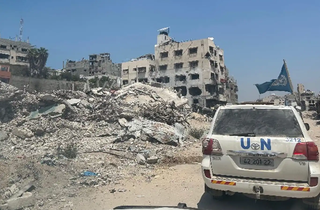According to OCHA, repeated waves of displacement, severe overcrowding, ongoing hostilities, and collapsing infrastructure are pushing Gaza towards a catastrophic scenario.
Humanitarian workers on the ground report that the latest Israeli evacuation order, issued last Saturday, has directly impacted approximately 13,500 displaced individuals across 18 locations. The affected areas include the entire Maghazi refugee camp and several neighborhoods in Deir al-Balah, located in the central part of the Gaza Strip.
OCHA has highlighted the extreme challenges faced by displaced families who are struggling to access basic services due to the ongoing aggression, evacuation mandates, and critical shortages of essential supplies. These challenges are compounded by the severe overcrowding in areas designated as safe by occupation authorities, which has significantly worsened the living conditions for those forced to relocate.
Since the escalation of Israeli aggression in October, over 86% of the Gaza Strip has been subjected to evacuation orders, leading to a dramatic concentration of the population in the Al-Mawasi area. This surge has caused the population density in the region to skyrocket, reaching between 33,000 and 34,000 people per square kilometer—an exponential increase from the pre-October density of about 200 people per square kilometer.
On the health front, the situation is equally dire. UN spokesperson Stephane Dujarric, in his daily press briefing, expressed grave concerns over the severe fuel shortages plaguing Gaza. These shortages are forcing hospitals to postpone essential surgeries and threaten to halt the operation of ambulances, particularly in the northern regions of the Strip.
The cumulative impact of these factors is contributing to what OCHA describes as a worsening humanitarian crisis, with the situation in Gaza growing increasingly desperate with each passing day. (ILKHA)



 Dünya
Dünya
 Güncel
Güncel
 Dünya
Dünya
 Güncel
Güncel
 Güncel
Güncel
 Dünya
Dünya
 Dünya
Dünya
 Güncel
Güncel
 Güncel
Güncel
 Dünya
Dünya





